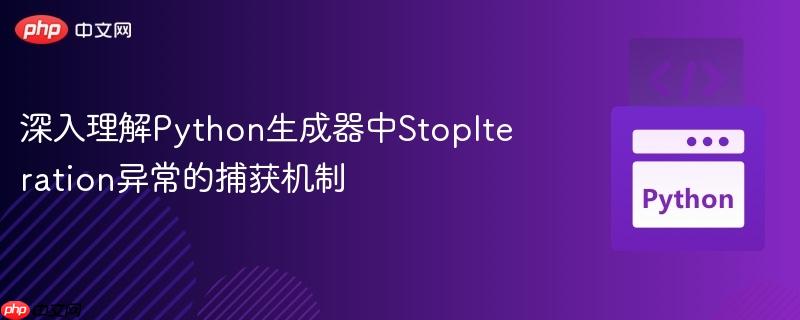
在Python中,生成器是一种特殊的迭代器,它使用yield语句来一次生成一个值。当生成器没有更多值可生成时,它会隐式地引发StopIteration异常,以信号通知迭代结束。外部的for循环或next()函数在捕获到此异常后,会优雅地停止迭代。
然而,当生成器逻辑变得复杂,尤其是在嵌套生成器或生成器表达式中调用next()时,StopIteration的捕获行为可能会出乎意料。
考虑以下尝试将一个主生成器分割成多个子生成器的场景:
def test(vid, size):
while True:
try:
# part 是一个生成器表达式
part = (next(vid) for _ in range(size))
yield part
except StopIteration:
# 期望在此捕获,但实际上不会发生
break
res = test((i for i in range(100)), 30)
for i in res:
for j in i: # 异常在此处发生
print(j, end=" ")
print()运行上述代码,会得到一个RuntimeError而不是预期的StopIteration被捕获。
立即学习“Python免费学习笔记(深入)”;
---------------------------------------------------------------------------
StopIteration Traceback (most recent call last)
Cell In[54], line 4, in (.0)
3 try:
----> 4 part = (next(vid) for _ in range(size))
5 yield part
StopIteration:
The above exception was the direct cause of the following exception:
RuntimeError Traceback (most recent call last)
Cell In[54], line 11
9 res = test((i for i in range(100)), 30)
10 for i in res:
---> 11 for j in i:
12 print(j, end=" ")
13 print()
RuntimeError: generator raised StopIteration原因分析:
可以类比以下简单函数来理解作用域问题:
def test2():
try:
def foo():
raise StopIteration
return foo # foo函数在此处并未被调用
except StopIteration: # 此处不会捕获到异常
pass
outer_foo = test2()
outer_foo() # <--- StopIteration 在此处被引发test2函数中的try...except块无法捕获foo函数被调用时抛出的异常,因为异常是在outer_foo()被执行时才发生的,而test2函数早已返回。同理,test函数中的try...except也无法捕获part生成器表达式迭代时发生的StopIteration。
要正确捕获StopIteration,必须在next(vid)实际被执行并可能引发异常的地方进行捕获。这意味着捕获逻辑需要移到子生成器内部。
考虑将生成器表达式part = (next(vid) for _ in range(size))展开成一个明确的内部生成器函数或循环:
# 这种形式下,StopIteration可以在内部被捕获
for _ in range(size):
yield next(vid) # <-- StopIteration可以在这里被捕获以下是一个能够正确处理StopIteration并实现分批生成器功能的解决方案:
def create_batches(source_generator, batch_size):
"""
将一个源生成器分割成多个子生成器,每个子生成器产生指定大小的批次。
当源生成器耗尽时,优雅地终止。
Args:
source_generator: 原始的生成器或可迭代对象。
batch_size: 每个批次(子生成器)的元素数量。
Yields:
一个子生成器,每次迭代产生一个批次的元素。
"""
done = False # 标志,指示源生成器是否已完全耗尽
def batch_generator_inner():
"""
内部生成器,负责从源生成器中获取单个批次的元素。
它会在内部捕获StopIteration,并更新外部的done标志。
"""
nonlocal done # 声明使用外部作用域的done变量
# print("--- new batch ---") # 调试信息
for i in range(batch_size):
# print(f"batch {i+1} / {batch_size}") # 调试信息
try:
yield next(source_generator)
except StopIteration:
# 捕获到StopIteration,表示源生成器已耗尽
# print("StopIteration caught, and we are done") # 调试信息
done = True # 设置标志,通知外部循环停止
break # 退出当前批次的生成
# 只要源生成器未完全耗尽,就不断生成新的批次生成器
while not done:
yield batch_generator_inner()
# 示例用法
print("--- 示例1:源生成器有余数 ---")
source_data = (i for i in range(10)) # 0到9共10个元素
batch_size = 3
batches = create_batches(source_data, batch_size)
for batch_idx, batch in enumerate(batches):
print(f"\n处理批次 {batch_idx + 1}:")
for elem in batch:
print(f" 元素: {elem}")
print("\n--- 示例2:源生成器刚好整除 ---")
source_data_exact = (i for i in range(9)) # 0到8共9个元素
batch_size_exact = 3
batches_exact = create_batches(source_data_exact, batch_size_exact)
for batch_idx, batch in enumerate(batches_exact):
print(f"\n处理批次 {batch_idx + 1}:")
for elem in batch:
print(f" 元素: {elem}")代码解析:
输出示例:
--- 示例1:源生成器有余数 --- 处理批次 1: 元素: 0 元素: 1 元素: 2 处理批次 2: 元素: 3 元素: 4 元素: 5 处理批次 3: 元素: 6 元素: 7 元素: 8 处理批次 4: 元素: 9 --- 示例2:源生成器刚好整除 --- 处理批次 1: 元素: 0 元素: 1 元素: 2 处理批次 2: 元素: 3 元素: 4 元素: 5 处理批次 3: 元素: 6 元素: 7 元素: 8
从输出可以看出,即使源生成器中的元素不足以填满最后一个批次,StopIteration也被正确捕获,并且生成器优雅地终止,没有引发RuntimeError。
itertools.islice:对于简单的分批需求,Python标准库中的itertools.islice是一个更简洁、更Pythonic的选择。它能够从迭代器中切片出指定数量的元素,并且在源迭代器耗尽时自动停止,无需手动处理StopIteration。例如:
from itertools import islice
def batched_islice(iterable, n):
it = iter(iterable)
while True:
chunk = tuple(islice(it, n))
if not chunk:
return
yield chunk
# 示例
for batch in batched_islice(range(10), 3):
print(batch)islice的内部实现会处理StopIteration,并返回一个空的迭代器,从而使外部循环终止。
明确作用域:始终记住,StopIteration异常必须在其被next()调用直接引发的作用域内捕获。生成器表达式会创建一个新的、独立的迭代作用域。
避免不必要的复杂性:如果不需要复杂的逻辑或状态管理,优先考虑使用itertools模块提供的工具,它们通常经过高度优化且不易出错。
在Python生成器编程中,理解StopIteration异常的传播机制至关重要。当在生成器表达式内部调用next()时,StopIteration不会在外部try...except块中被捕获,而是会作为RuntimeError传播出去。正确的做法是将try...except StopIteration块放置在next()调用发生的具体位置(通常是内部循环或子生成器中),并使用适当的标志来协调外部生成器的终止。对于常见的批处理任务,itertools.islice提供了一个更简洁高效的解决方案。掌握这些原则有助于编写出更健壮、更易于维护的Python生成器代码。
以上就是深入理解Python生成器中StopIteration异常的捕获机制的详细内容,更多请关注php中文网其它相关文章!

每个人都需要一台速度更快、更稳定的 PC。随着时间的推移,垃圾文件、旧注册表数据和不必要的后台进程会占用资源并降低性能。幸运的是,许多工具可以让 Windows 保持平稳运行。

Copyright 2014-2025 https://www.php.cn/ All Rights Reserved | php.cn | 湘ICP备2023035733号